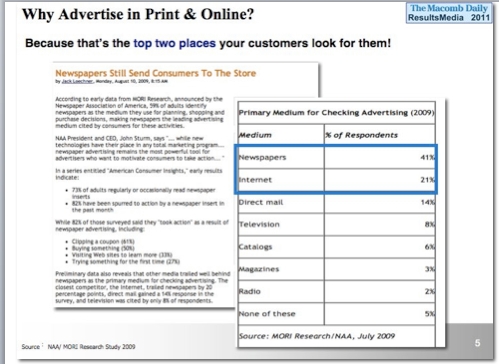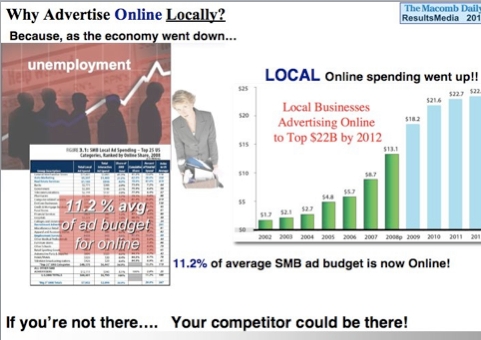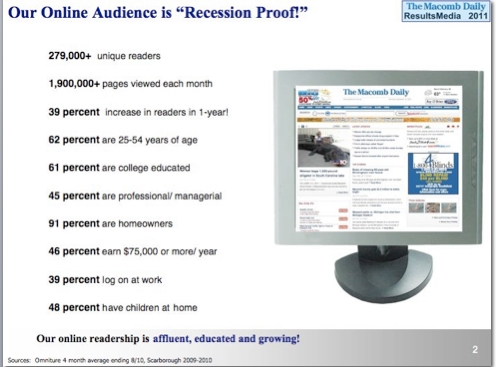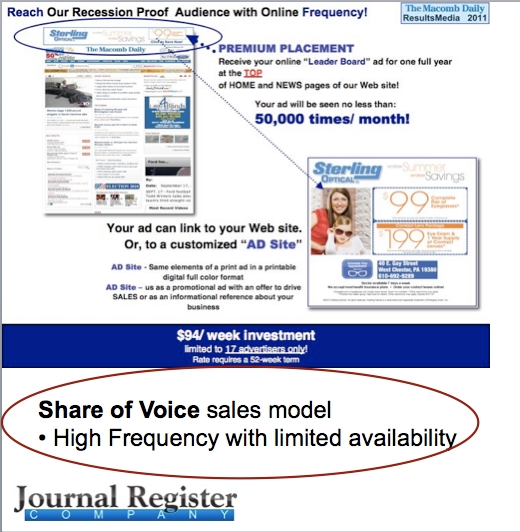Journal Register's online display contest generates $740,000
Summary: A Journal Register companywide sales promotion in Philadelphia resulted in 165 sales and $740,000 in new revenues in one month. Led by Blinder & Associates sales consultants, the initiative has been the JR's single largest online revenue generated this year. Simple $94 a week packages, including splash pages, and limited inventory are key to the promotion. Here's a detailed anatomy of how it works.
Company: Journal Register
Sites: 18 dailies and three major weekly groups in Pennsylvania, New Jersey, Connecticut, Michigan and Ohio
Initiative: Increase local online display advertising
Key Executive: John Krivosheyff, Director of training and development
Consultant: Mike Blinder, Blinder & Associates
Challenge: Journal Register Philadelphia/New Jersey publications group includes 21 small marketdaily and weekly newspaper sites with circulation in the range of 7000 a week to 34,000 a day. Training 161 sales representatives to engage their advertisers in buying online display advertising has been a challenge. “We wanted to empower our local sales staff to close deals that extended reach and got better results for local businesses,” says John Krivosheyff. Affordability of online advertising was key to the new sales packages, but “our goal was that every penny of print was important; this was to extend reach."
Strategy: The group decided to bring in Blinder Group to structure packages and kick start an online sales contest. The goal create high value, dirt simple packages aimed at small and mid-sized businesses, and train the staff on key benefits. The devil's in the details of how these packages were structured, with one product and one price at less thatn $100 a week. “Its so simple. That's what beautfiul, its so simple that it works.The local main stream business person is not looking for complexity," Krivosheyff says. The principles of "de-geeking" sales for Mainstreet.
1. The anatomy of a package even the dry cleaner can understand
The small business packages here are worth studying - they combine a number of field-tested principles of packaging and pricing structured for small markets.
• Desirable channels. Home page and news - into packages, in this case a small, but robust number of 50,000 impressions each. For more sophisticated advertisers targeting has higher click-through and is a better buy, but for start-up advertisers, home page packages incite more enthusiasm and are easier to understand.
• Desirable Create Ad formats. Instead of one ad format, the package included the much sexier “road block,” ie the top leaderboard and right hand 300x 250 rectangle; all of the top of fold inventory.
• Utilize 70% of inventory to leave room for national and major account sales. For some markets that meant 19 packages, for others less. Instead of a pure Share of Voice model, this "limited number of packages" model still creates scarcity. Advertisers were told, “We only have ten and once they are gone, they are gone.
• Affordable pricepoint. Packages were priced at $94 a week, staying under $400 a month, to appeal to smaller businesses as an add-on. “ A lot of people said for that amount of money count us in," Krivosheyff says, "But we actually maintained rate integrity."
• Annual agreements required. Since packages are on the 52 time rate, each contract was worth $4800. Only a few customers were granted a six month written opt-out provision.
2. A splash page for every campaign, encouragement of great offers.
Splash pages that matched the banner ads were created for every advertiser. These mirrored the banner campaign and expand upon the offer. Krivosheyff says this answered the biggest objection in the field, that "SMB's are not happy with their web sites, or were under construction with their current site.” Deploying the splash page also allowed advertisers to be more creative with their offers, since they did not have to make changes on their own sites.
3. Motivating the sales team
•Generous spiffs to sales representatives included $100 per contract and $10 per selling appointment with a decision-maker.
• Blinder Group trained and kick off the drive with four-legged field calls. Outside consultants often deliver a better result due to the “outsider halo”. "Our internal online staff begins to sound like the teacher in Charlie Brown, "Wah wah... . from outside for some reason people get up and move,” says Christensen. “Having Blinder Group associates train was one of the reasons for the success.”
4. Targeting existing accounts
Most of the sales were to existing accounts, or accounts who had advertised recently. These advertisers already knew their representative and had committed to advertising. "For a lot of print advertisers, digital display is still a shiny new toy." This allowed the group to achieve a 64% one call close rate. Since the number one objection was “wrong decision-maker” this rate was actually much higher.
5. Structured sales calls
Finally, the sales representatives were trained on simple structured presentations, that included media trends showing online display advertising's resistance to recession, typical percentage of the marketing mix and desirable audience of affluent, younger, educated and employed customers.
• Short form needs analysis. Since these are people areadly buying print, the needs analysis was to acquire fast facts, leading with online. "What has you done online? What's been successful?"
• Presentating facts. After obtaining basic information about current online strategies - most had a web site without a startegy - the reps used powerpoint/take-outs (images on the right) that showed a few key facts about online display advertising:
a. The Borrell chart showing that even as unemployment went up, local online advertising continued to increase and recommending an 11.2% spend, just to keep up.
b. Use of Scarborough Research to show online readers are a desirable new group: employed, affluent and younger, reading online at work.
c. NAA/Mori Survey that shows the "Primary Medium for Checking Advertising (2009) is still newspapers followed by newspaper sites.
d. Close with a printed visual of Road Block packages with $94 a week price. Krivosheyff says that he personally went on 20 sales calls, and the price point was a key selling point.
Results: With 164 closed annual agreements from 161 sales people on the small market teams throughout Pennsylvania in two week, the drive totaled $760,000 in new business. Of the closes, one third were up-sells to existing advertisers to gain share of customer, one third were full year contracts with dormant sporadic advertisers and one third were new advertisers, most of whom been called on but had never bought print. Our comment: This is is a terrific first package to engage large groups in increasing online sales quickly. For big organizations, think on average about one contract per sales rep, or number of reps times $4800, with some groups having more than one. Krivosheyff says that about 92% of the teams across his company fully participated.

The author, Alisa Cromer is publisher of a variety of online media, including LocalMediaInsider and MediaExecsTech, developed while on a fellowship with the Reynolds Journalism Institute and which has evolved into a leading marketing company for media technology start-ups. In 2017 she founded Worldstir.com, an online magazine, to showcases perspectives from around the world on new topic each month, translated from and to the top five languages in the world.













